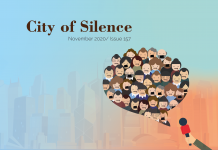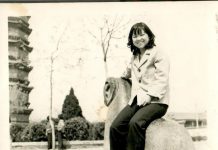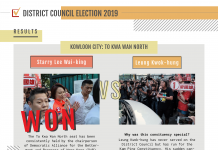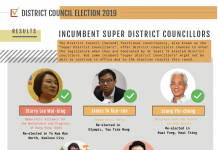Green funerals face obstacles in traditional Hong Kong
by Mavis Wong and Edith Lin
Smouldering sticks of incense, elaborate floral wreaths and the burning of paper replicas of worldly goods and money for the afterworld are common features of traditional Chinese funerals.
For many people, a funeral is not just a traditional rite but also an event where family and friends join together to bid farewell to the deceased.
However, they also use up a lot of material and generate a lot of waste. A typical funeral flower basket uses around 5 kg of flowers, and a traditional hardwood coffin is made from about 150 kg of wood.
As society has become more aware of environmental issues, green organisations have started to promote green funerals in Hong Kong. They are exploring whether traditional customs can be modified to achieve sustainability.
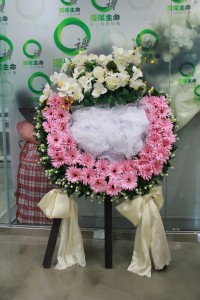
Some people are already waking up to how wasteful a traditional funeral can be. Angela Siu Tsui-yee, recently helped to arrange her father-in-law’s funeral says, is one of them. “When I saw his coffin being put into the grave, I felt it was very wasteful, the wood was so thick… a lot of trees were probably cut down to make it,” says the 49-year-old. What is more, Siu says the funeral cost the family more than HK$100,000.
In contrast, a green funeral should be based on environmentally friendly principles and should use the least materials possible. Those at least are the tenets of Hong Kong’s only specialist eco-friendly funeral home, Green Life Passage, which advocates the use of reusable materials yet avoids sacrificing Chinese traditions altogether.
Green Life Passage suggests people replace fresh flowers with flowers made of ribbon or making donations to charity in lieu of floral tributes. It uses paper coffins instead of traditional hardwood ones, and substitutes the traditional attire worn by the deceased with their regular clothing, while family members are encouraged to re-use or recycle their mourning clothes.
People often assume the elderly treat death as a taboo, and the subject should not be broached. But Lam Ka-hei, chief executive of Green Life Passage, says the opposite is true.
Lam says the company once held a talk at an elderly centre where members of staff were afraid that showing a real coffin to the elderly people would scare them. To their surprise, the seniors were actually interested to know more. “The elderly love to take a look at or even touch the coffins,” says Lam. “[They might think] this is a matter closely related to me, of course I want to learn more about it beforehand!”
Although an increasing number of green organisations have started to educate people about green funerals, an environmentally friendly send-off still faces numerous challenges in Hong Kong.
The first challenge is overcoming traditional practices. Angela Siu says her husband’s eldest brother expected the family to organise a large-scale funeral just as other relatives had in the past. He was afraid people would laugh at them otherwise.
Also, members of the older generation may think that the more material is used in a funeral, the more respectful the mourners are. These deeply held views are hard to shake.
Michael Cheung Quan-bik, assistant funeral services manager at the Kowloon Funeral Parlour, says these traditional thoughts are the reason they rarely promote eco-coffins. He explains the rate of usage of eco-coffins is very low. Sometimes, not even one can be sold in a month.
Even those who choose to use eco-friendly funeral services may worry about the repercussions of not following Chinese traditions.
Leung Tin-ying, who is in her 60s, chose Green Life Passage as the undertakers for her mother’s funeral. “I also experienced some internal conflict at first,” she says. Unsure of whether her father and other relatives would support the move, she decided to take things step by step.
First, Leung collected information from both traditional funeral homes and Green Life Passage. Only when she was sure her father did not oppose the idea of a green funeral, did she go ahead with using Green Life.
To avoid disputes over how a funeral should be held, Catherine Hung Hing-ling, chairperson of Club-O, an organisation promoting green living attitudes, suggests the elderly should write down their expectations for their own funeral. Green Life Passage also provides a simple form for elderly people to fill in their wishes.
By making their wishes known while they are alive, people can save their loved ones from anxious second-guessing and uncertainty.
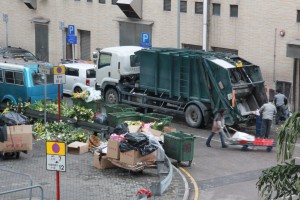
“If you love a person, you should not just express your care after they pass away,” says Hung. When she sees people spending a lot of money to make a funeral look “good”, Hung questions whether the rite is being observed for the living or for the deceased. “[The value] has changed. Now ‘wasting’ is important, it is done for show, to put people at ease.”
Religious belief is another deciding factor in how a funeral is conducted. In Hong Kong, practices from the main religions, Buddhism, Taoism and Christianity, are commonly incorporated into the funeral setting.
Among these, Taoist and Buddhist funerals involve relatively more rituals and offerings, and cost around HK$10,000 to HK$20,000 more than Christian and Catholic funerals. Followers of Buddhist and Taoist practices generally find it harder to forego traditional funerary rites and adopt green funeral arrangements.
Another challenge to green funerals comes from the established business practices of funeral parlours providing one-stop services. These will arrange everything – from the coffin to the hall for the ceremony and the disposal of ashes.
Yet, most funeral parlours will not offer a greener approach unless a customer specifically asks for it. When Angela Siu sought help from the undertaker, he simply gave her a price list, showing her the prices of funeral services based on different religions and the scale of the funeral. “They do not have other options for you, not even one involving a green funeral,” Siu says. “I did not even have a chance to consider it.”
Kitty Yeung Kit-ling, who organised a Buddhist funeral for her mother, agrees with Siu that there is a lack of options for green funerals. She observes the mass media and funeral homes have done little to promote green funerals and paper coffins.
Varsity called seven major funeral parlours in Hong Kong to inquire about funeral packages. At first, none of them mentioned green funeral packages. When asked if there was a greener option, six of them offered the eco-coffin. The price of eco-coffins, however, was more expensive than ordinary coffins in three of the funeral parlours. One funeral parlour, Po Fook Memorial Hall did not offer an eco-coffin even when asked.
On paper, the government supports the development of green funerals. In 2008, the Food and Environmental Hygiene Department (FEHD) imposed an additional licensing condition on all newly issued and renewed Undertakers of Burials Licenses, requiring holders to provide eco-coffins as an option.
However, the effectiveness of such a requirement in promoting green funerals is questionable. According to the statistics of the FEHD, there are around 40,000 deaths every year but only around 1,000 funerals involve eco-coffins. This low number – just 2.5 per cent of all funerals – illustrates the lack of popularity of eco-coffins and green funerals.
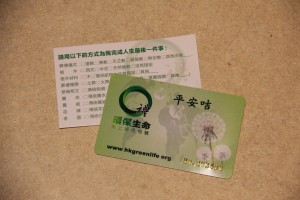
Eric Chan Wai-man, chief operating officer of Green Life Passage, says that while the government claims to promote eco-coffins, there are loopholes in the licensing condition. For starters, it does not provide for a qualitative assessment of the provision of eco-coffins. Chan says undertakers can simply fulfill the licensing condition by merely showing photos of the eco-coffin to customers, or even mentioning it verbally.
“Even for those funeral parlours that have a showroom for coffins, they will not show you a paper coffin. If you were a customer, can you purchase a paper coffin? You cannot even see the product; how can you choose the paper coffin?” asks Lam.
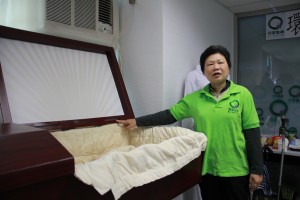
Moreover, this licensing condition does not include a definition of what an eco-coffin is. Most of the eco-coffins in funeral parlours look very similar to hardwood coffins, with a carved shape on top and decorations around it. It requires a large amount of paper to produce such an appearance and it is questionable just how environmentally friendly such coffins can be.
Green Life Passage is also frustrated with the government’s response to a mourning clothes recycling programme it proposed in 2013. The company wants to collect mourning clothes in the crematoria for reuse but has yet to receive a formal affirmative reply from the government. Chan explains the FEHD is responsible for the management of cemeteries and crematoria, while the Environmental Protection Department (EPD) is in charge of recycling. He says the departments have pushed back and forth the responsibility of dealing with the programme.
In response to the negative comments on the government’s policies and promotion, Robert Lai Chi-ho, health inspector (cemeteries and crematoria) from the FEHD, says the government has been striving to promote the use of eco-coffins.
Lai says the FEHD has stepped up publicity to promote the use of eco-coffins through various channels, such as publicity leaflets. However, he adds that his department has no power over other whether other governmental departments distribute the leaflets or not.
Despite all the challenges to the development of green funerals in Hong Kong, advocates are still hopeful. Although Kitty Yeung ended up deferring to her mother’s wishes in organising a Buddhist funeral, she believes it is a matter of time before people will come around to accepting green funerals. “It also took many years to accept the idea of cremation, but now many people will choose cremation,” she says.
Leung Tin-yin, who did choose a green funeral for her mother, puts it this way, “I think humans use up many of the earth’s resources over their whole life. In the final stage, we should save whatever can be saved, in order to make the sustenance of life on earth more possible.”
Edited by Charlene Kwan




